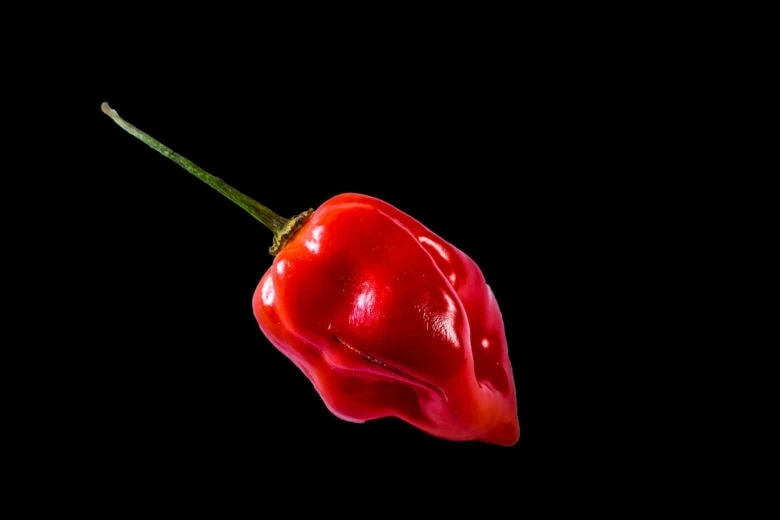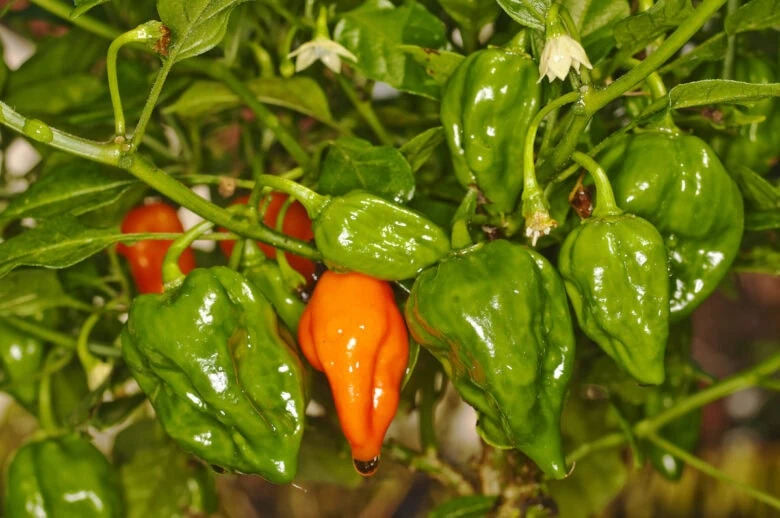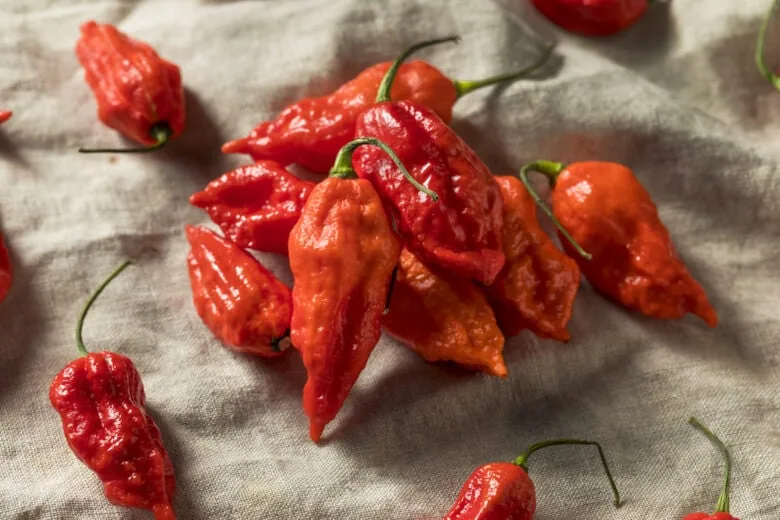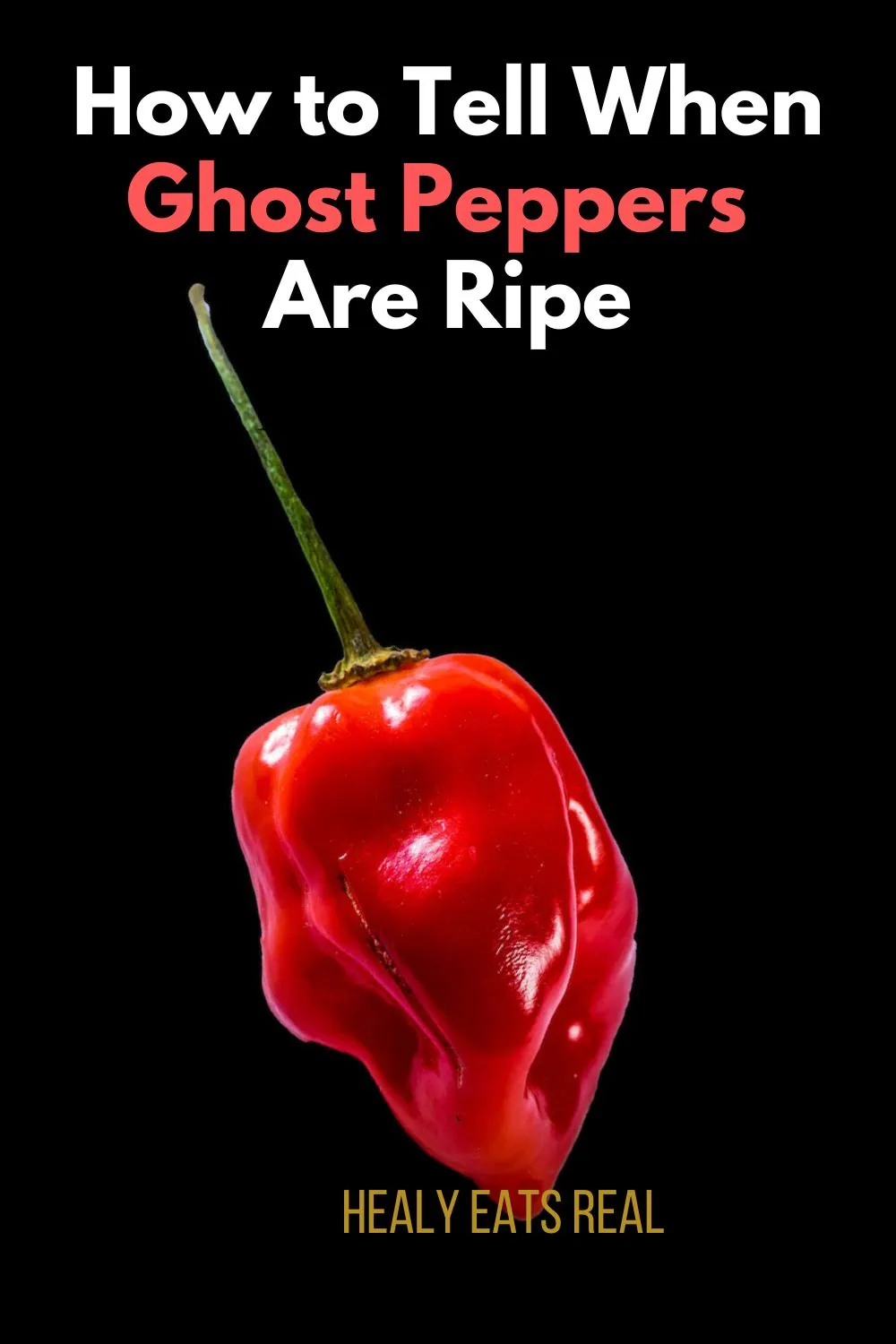How to Tell When Ghost Peppers Are Ripe for Harvesting
This post may contain affiliate links. As an Amazon Associate I earn from qualifying purchases. Please read the disclosure policy.
Knowing how to tell when ghost peppers are ripe is essential to enjoying their trademark intense heat. When growing these plants, their spicy potency peaks at the final stages of growth.

What Are Ghost Peppers?
The Ghost pepper is among the world’s hottest pepper, reaching about one million Scoville heat units (the official measurement of pepper spiciness). Compare that to cayenne peppers at 30,000-50,000 Scoville or a jalapeño pepper at about 3500-8000 Scoville. For the 2007 Guinness World Records, ghost peppers were crowned as the hottest peppers.
They originate from northeast India and are known in the area as bhut jolokia, which loosely translates to ghost pepper. These fiery peppers are actually a hybrid of Capsicum chinense and Capsicum frutescens. Roughly the size of habanero peppers, ghost peppers are most commonly red in color, although some rare breeds can come in white, yellow, or green. The red varietals are usually hotter peppers.
These sun-loving chili pepper plants are easy to grow and even easier to harvest. So, if it’s your first time growing them, you can rest easy; they won’t give you a hard time.
How to Use Ghost Peppers in Your Cooking
These hot peppers are great for hot sauce, pot beef chili, salsa, and much more. However, due to their high level of spice, they should be used very sparingly and with caution. Consuming too many ghost peppers can result in serious issues, like one man’s esophageal rupture after participating in a pepper-eating contest. This was a rare instance, and it’s highly unlikely that this would happen to anyone eating these peppers in moderation, though.
What Do Ghost Peppers Taste Like?
Ghost peppers are usually described as having a somewhat sweet, fruity, chili flavor, but once the heat kicks in after about half a minute, your mouth will likely be burning too much to taste anything. As one of the spiciest chilis worldwide, the intense heat will linger in your mouth along with sweating, tears, and digestive distress for up to 40 minutes.
What Does A Ripe Ghost Pepper Look Like?
There are several types of ghost chili peppers, and their characteristics, when ripe, depend on the variety being grown. Red peppers are the most commonly grown variety. When grown on the vine, they start as green ghost peppers, then change to a placid orange and, finally, a vibrant red at maturity.
Other varieties of ghost pepper plants include chocolate ghost pepper, white ghost pepper, yellow bhut jolokia, and the peach ghost scorpion. Apart from their unique colors, there aren’t really other staggering differences between these varieties of ghost peppers. They have varying heat levels, but they aren’t too far off; the same can be said about their flavor profiles.
A general rule of thumb for identifying ripe ghost peppers is to look out for peak developments in color and size about 4-6 weeks into the growing season or after the plant starts to fruit. Ripe ghost peppers are usually red when ripe unless you have a special variety that may be white or yellow when mature.

When to Pick Ghost Peppers
Typically, ghost peppers are picked after they undergo their final color transition. However, this doesn’t always guarantee a successful harvest.
Here are other things to look out for to ensure you’re picking at the right time.
- Firmness: ripe ghost peppers should be slightly yielding but firm to the touch. So before picking, make sure you gently squeeze your peppers after they have changed color to ensure they have the right feel.
- Size: mature ghost peppers should measure 2.5 to 3.3 inches long and have the right texture and color.
- Shape: you’ll know almost right away when your ghost peppers are ripe after they change color and start to look plump and wrinkly. This is a crucial indicator that they are ready to be picked.
You don’t want to leave ripe peppers on the vine for too long, or you may start to notice signs of pests. The longer you leave them on the plant, the more vulnerable they are to insects like aphids.
How Do I Harvest Ripe Ghost Peppers?
Harvesting ripe ghost peppers is pretty straightforward. It’s a simple two-step process that can be done bare-handed or with gardening gloves.
Identify Ripe Ghost Peppers
You can usually identify ripe ghost peppers by their changing color (red for most varieties), but you should also consider other factors before picking them.
They shouldn’t be too firm, their exterior should be a bit wrinkly and plump, and they should be about an inch wide and 2-3 inches long.
Gently Grab Hold of the Stem and Tug the Pepper from the Shrub
Attempting to harvest ripe peppers from your ghost pepper plant without supporting the stem can damage the plant or roots. For best results, it’s a good idea to gently grab onto the pepper stem before picking ripe peppers off the stalk. Then, pull the ripe pepper away from the shrub until it’s disconnected from its stem.
When picking ghost peppers, there’s a high chance you’ll get capsaicin on your hands, which can burn your eyes or skin if you happen to touch them after touching the peppers. To avoid this, it’s best to wear gloves for harvesting or thoroughly wash your hands afterward.
Will Ghost Peppers Ripen Off the Vine?
Ghost peppers can ripen off the vine if they are well into the final stage of development. So, if you pick a pepper that’s not quite ready, it can continue to mature on its own to develop the right flavor and heat level.
This stage is also known as the ripening stage; peppers removed here will ripen even faster if left out on a countertop or in a bowl at room temperature until you notice the color change.
Storing transitioning peppers in the freezer or refrigerator will stop the ripening process altogether.
However, if you pick ghost peppers too early in their development, they will most likely not ripen off the vine.
The good news is that unripe ghost peppers are just as edible as ripe ghost peppers, although they are not as sweet or spicy.
How to Protect Ghost Pepper Plants from the Cold
Ghost pepper plants generally like warmer climates, between 70-90 degrees Fahrenheit during the day and around 60 degrees at night, so it’s important to take certain precautions if it gets much colder than that.
To save your peppers from frostbite, you’ll want to consider ripening off the vine and/or transplanting your plants once it starts getting cold out.
If your ghost pepper plants are potted, you can bring them inside and leave them in a warm spot where they’ll get lots of light. You can also use grow lights to compensate for less sun exposure.
Predominantly warm weather with a few cold nights usually won’t pose any threat to your pepper plants. However, a great way to go the extra mile to protect your peppers is by creating floating row covers.
The floating row cover method is not recommended if nighttime temperatures are dropping far below 55°F(13°C).

How to Encourage Peppers to Ripen on the Vine
Waiting for ghost peppers to ripen after they’ve reached their full size can be frustrating. Even after you see peppers sprouting on your plant, it can still take 4-6 weeks to get to harvest them. However, there are some things you can do to help encourage this process.
Maintain Adequate Sunlight Exposure
Make sure your plants are getting full sun exposure. This is easier to implement if you’re growing your ghost peppers in containers. All you need to do is move your plants to the spots that get the most sunlight.
Sometimes, sun patterns change, and sunny spots become shady, so pay close attention to your pepper plants for most of the growing season.
If you’re growing in raised beds or an outdoor garden, make sure to plant them in a spot that you know will get good sun exposure.
Get Rid of Weeds
The last thing you need is weeds competing for the nutrients meant solely for your ghost pepper plants. So, make sure that you stay on top of removing as many weeds as possible.
Steer clear from herbicides, especially if you’re growing your peppers in a home garden; they may kill bees needed for pollination.
Routinely Feed and Water Your Plants
Fertilizing and watering play a significant role in the proper care of your ghost pepper plants and pretty much any other plant.
For a healthy ghost pepper plant, fertilization should be done every 4-6 weeks during the growing season, and watering should be done every week.
Do not water your ghost pepper plants with anything more than an inch of water weekly to maintain good soil moisture content and ensure the soil is well-draining.
You can further add mulch to safeguard against dehydration in hot weather.
Prune to Stop Further Fruiting/Flowering
This tip is most handy if you’re trying to get your ghost peppers to ripen before the cold weather sets in.
You don’t really need your ghost pepper plants trying to produce fruit when they’re practically shutting down due to the oncoming cold weather.
If you want your peppers to ripen faster, the best thing to do is cut off the tips that are at the early stages of growth; this way, the plant channels all its energy toward ripening significantly developed peppers.



